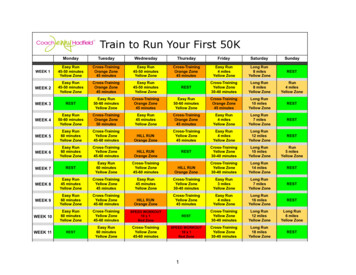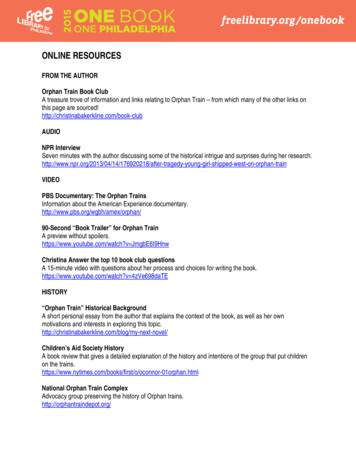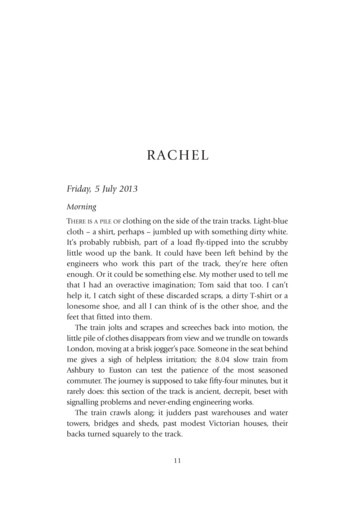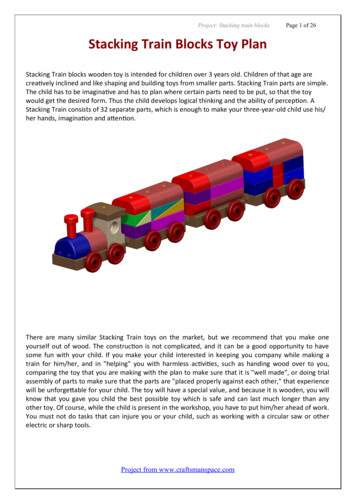
Transcription
Train to Run Your First dayWEEK 1Easy Run45-50 minutesYellow ZoneCross-TrainingOrange Zone45 minutesEasy Run45-50 minutesYellow ZoneCross-TrainingOrange Zone45 minutesEasy Run4 milesYellow ZoneLong Run8 milesYellow ZoneRESTWEEK 2Easy Run45-50 minutesYellow ZoneCross-TrainingOrange Zone45 minutesEasy Run45-50 minutesYellow ZoneRESTCross-TrainingYellow Zone30-40 minutesLong Run8 milesYellow ZoneRun4 milesYellow ZoneWEEK 3RESTEasy Run50-60 minutesYellow ZoneCross-TrainingOrange Zone45 minutesEasy Run50-60 minutesYellow ZoneCross-TrainingOrange Zone45 minutesLong Run10 milesYellow ZoneRESTWEEK 4Easy Run50-60 minutesYellow ZoneCross-TrainingOrange Zone50 minutesEasy Run45 minutesYellow ZoneCross-TrainingOrange Zone45 minutesEasy Run4 milesYellow ZoneLong Run7 milesYellow ZoneRESTWEEK 5Easy Run60 minutesYellow ZoneCross-TrainingYellow Zone45-60 minutesHILL RUNOrange ZoneCross-TrainingYellow Zone45 minutesEasy Run4 milesYellow ZoneLong Run12 milesYellow ZoneRESTWEEK 6Easy Run60 minutesYellow ZoneCross-TrainingYellow Zone45-60 minutesHILL RUNOrange ZoneRESTCross-TrainingYellow Zone30-40 minutesLong Run10 milesYellow ZoneRun5 milesYellow ZoneWEEK 7RESTEasy Run60 minutesYellow ZoneCross-TrainingYellow Zone45-60 minutesHILL RUNOrange ZoneCross-TrainingYellow Zone30-40 minutesLong Run14 milesYellow ZoneRESTWEEK 8Easy Run45 minutesYellow ZoneCross-TrainingYellow Zone45 minutesEasy Run45 minutesYellow ZoneCross-TrainingYellow Zone30-40 minutesEasy Run3 milesYellow ZoneLong Run7 milesYellow ZoneRESTWEEK 9Easy Run60 minutesYellow ZoneCross-TrainingYellow Zone45-60 minutesHILL RUNOrange ZoneCross-TrainingYellow Zone45 minutesEasy Run4 milesYellow ZoneLong Run16 milesYellow ZoneRESTWEEK 10Easy Run60 minutesYellow ZoneCross-TrainingYellow Zone45-60 minutesSPEED WORKOUT10 x 1Red ZoneRESTCross-TrainingYellow Zone30-40 minutesLong Run12 milesYellow ZoneLong Run6 milesYellow ZoneWEEK 11RESTEasy Run60 minutesYellow ZoneCross-TrainingYellow Zone45-60 minutesSPEED WORKOUT10 x 1Red ZoneCross-TrainingYellow Zone30-40 minutesLong Run18 milesYellow ZoneREST1
WEEK 12Easy Run45 minutesYellow ZoneCross-TrainingYellow Zone45 minutesEasy Run45 minutesYellow ZoneCross-TrainingYellow Zone30-40 minutesEasy Run3 milesYellow ZoneLong Run7 milesYellow ZoneRESTWEEK 13Easy Run60 minutesYellow ZoneCross-TrainingYellow Zone45-60 minutesSPEED WORKOUT6x2Red ZoneCross-TrainingYellow Zone45 minutesEasy Run4 milesYellow ZoneLong Run20 milesYellow ZoneRESTWEEK 14Easy Run60 minutesYellow ZoneCross-TrainingYellow Zone45-60 minutesSPEED WORKOUT6x2Red ZoneRESTCross-TrainingYellow Zone30-40 minutesLong Run14 milesYellow ZoneLong Run7 milesYellow ZoneWEEK 15RESTEasy Run45 minutesYellow ZoneCross-TrainingYellow Zone45-60 minutesEasy Run45 minutesYellow ZoneCross-TrainingYellow Zone30-40 minutesLong Run7 milesYellow ZoneRESTWEEK 16Easy Run60 minutesYellow ZoneCross-TrainingYellow Zone45-60 minutesTEMPO WORKOUT5x5Orange to Red ZoneCross-TrainingYellow Zone45 minutesEasy Run4 milesYellow ZoneLong Run22 milesYellow ZoneRESTWEEK 17Easy Run60 minutesYellow ZoneCross-TrainingYellow Zone45-60 minutesTEMPO WORKOUT25 minutesOrange to Red ZoneRESTCross-TrainingYellow Zone30-40 minutesLong Run16 milesYellow ZoneLong Run8 milesYellow ZoneWEEK 18RESTEasy Run45 minutesYellow ZoneCross-TrainingYellow Zone45-60 minutesEasy Run45 minutesYellow ZoneCross-TrainingYellow Zone30-40 minutesLong Run8 milesYellow ZoneRESTEasy Run60 minutesYellow ZoneCross-TrainingYellow Zone45-60 minutesHILL TEMPO WORKOUTWEEK 19Cross-TrainingYellow Zone45 minutesEasy Run4 milesYellow ZoneLong Run23 milesYellow ZoneRESTWEEK 20Easy Run60 minutesYellow ZoneCross-TrainingYellow Zone45-60 minutesTEMPO WORKOUT25 minutesOrange to Red ZoneRESTCross-TrainingYellow Zone30-40 minutesLong Run18 milesYellow ZoneLong Run8 milesYellow ZoneWEEK 21RESTEasy Run45 minutesYellow ZoneCross-TrainingYellow Zone45-60 minutesEasy Run45 minutesYellow ZoneEasy Run3 milesYellow ZoneLong Run8 milesYellow ZoneRESTWEEK 22Easy Run60 minutesYellow ZoneCross-TrainingYellow Zone45-60 minutesTEMPO WORKOUT5x5Orange to Red ZoneRESTCross-TrainingYellow Zone30-40 minutesLong Run12 milesYellow ZoneLong Run6 milesYellow ZoneWEEK 23RESTEasy Run50 minutesYellow ZoneCross-TrainingYellow Zone45 minutesCross-TrainingYellow Zone30 minutesLong Run7 milesYellow ZoneEasy Run3 milesYellow ZoneWEEK 24RESTEasy Run40 minutesYellow ZoneEasy Run30 minutesYellow ZoneEasy Run20 minutesYellow Zone50K Race!RESTOrange to Red ZoneHILL TEMPO WORKOUTOrange to Red ZoneREST2
WEEK 25RECOVERYRESTMassageWEEK 26RESTRECOVERYWEEK 27RECOVERYRESTMassageCross-TrainingYellow Zone20 minutesRESTCross-TrainingYellow Zone30 minutesRESTCross-TrainingYellow Zone30 minutesEasy Run3 milesYellow ZoneEasy Run30 minutesYellow ZoneCross-TrainingYellow Zone30-40 minutesRESTCross-TrainingYellow Zone30 minutesEasy Run3-5 milesYellow ZoneRESTEasy Run45 minutesYellow ZoneCross-TrainingYellow Zone30-45 minutesEasy Run45 minutesYellow ZoneCross-TrainingYellow Zone30 minutesEasy Run4-6 milesYellow ZoneRESTGETTING STARTED:You’ve run a marathon and now you’ve got the bug and want to try an ultra-marathon 50K. Excellent, you’re in the right place. The First 50K Training Planis designed for those that have run at least one marathon, and want to build on their experience and run a longer race. It’s also geared to those who havebeen running at least four times per week for 20 miles per week, or 4-7 miles per run.If you’re running less, no worries, simply invest in a few more weeks of training to build your running time up to that level so you’re ready to tackle thedemands of this program.This program is 24 weeks in duration to allow your body time to adapt to the demands of building your mileage up to run the 50K Ultra-Marathon distance.The duration of the plan also allows for life’s detours along the way (vacation, illness ).WARM UPWarm up by walking for 3 minutes before every running workout. Start easy and build to a brisk and close to running pace by the end. This graduallyincreases heart rate, breathing rate and circulation to the working muscles.COOL DOWNCool down by walking 3-5 minutes after every run, starting at a brisk pace and slowing towards the end. This gradually brings your body back to its restingstate and aids in flushing the muscles of metabolic waste.LONG RUNSThe longer runs are the bread and butter of the ultra training plan. They build with longer single runs, moderately long back-to-back runs, and recoverylong runs. You’ll notice that the long runs are to be run in the easy, yellow zone effort (Zone 1-2). This is to build your endurance, teach your body to burnfat as a fuel source, and assure optimal recovery. If possible, run these on courses that are similar to your 50K course.EASY RUNSThe shorter, easy, yellow zone runs bridge the gap between your long runs, build your aerobic fitness and aid in allowing your body to recover from thedemands of the faster and longer runs. If you’re having a tough week, feel free to shorten this run, but keep 'er easy. If you use a heart rate monitor, theYellow Zone includes Zone 1 and 2.REST DAYSThese are your off days from training and activity. They aid in passive recovery from the demands of the progressive training plan and are just as importantas the workouts. Without rest, our body will break down. Be mindful to rest on these days, and if you're feeling tired and fatigued, add a few to your planalong the way.3
CROSS-TRAININGMix up your program on the cross-training days and include lower impact activities like cycling, elliptical, yoga, and strength training. A good examplewould be to perform the elliptical machine for 20-30 minutes followed by a total body strength program or yoga poses. Strength and flexibility are yourbest friends on this journey. Yoga is an amazing tool for your toolbox, as it lengthens and strengthens your muscles, build mental focus, and teaches you tobreathe rhythmically. Keep them close, and make sure to include them twice every week because they will keep you running happy and injury free.HILL RUNThe Hill Run is designed to build strength, fitness, and technique. You can run this Treadmill Hill Workout, or find a 1-2 minute hill, and run this workoutoutdoors.Warm up walking for 3 minutes, starting easy and build to a brisk pace by the end.Run 10 minutes in your easy yellow zone effort.Repeat 6 times:Run 1 minute at 3-4% incline and in your Orange Zone Effort (Zone 3)Run 1 minute at 0% at an easy effort zone to recoverRun 2 minutes at 3-4% incline in your Orange Zone Effort (Zone 3)Run 2 minutes at 0% at an easy effort zone to recoverRun 5 minutes in your easy yellow zone effort.Cool down walking for 3 minutes, starting at a brisk pace and slowing by the end.SPEED WORKOUTSThe speed runs are shorter in time, but pack a punch with red zone running intervals. You’ll improve your speed, fitness and form with these fun runs andthe time will fly by!Speed Workout 10 x 1Warm up walking for 3 minutes, starting easy and build to a brisk pace by the end.Run 15 minutes in your easy yellow zone effort.Repeat 10 times:Run 1 minute at your Red Zone Effort (Zone 5)Follow with 2 minutes of very easy jogging or walking to catch your breath.Run 5 minutes in your easy yellow zone effort.Cool down walking for 3 minutes, starting at a brisk pace and slowing by the end.Speed Workout 6 x 2Warm up walking for 3 minutes, starting easy and build to a brisk pace by the end.Run 10 minutes in your easy yellow zone effort.Repeat 6 times:Run 2 minute at your Red Zone Effort (Zone 5)Follow with 3 minutes of very easy jogging or walking to catch your breath.Run 5 minutes in your easy yellow zone effort.Cool down walking for 3 minutes, starting at a brisk pace and slowing by the end.4
TEMPO RUNSThese are a favorite among runners because they’re done at an effort that feels good and empowering. It’s somewhere between and easy and hard runningeffort, and can be quite the cathartic experience when you’re finished.Tempo Workout 5 x 5Warm up walking for 3 minutes, starting easy and build to a brisk pace by the end.Run 10 minutes in your easy yellow zone effort (Zone 1-2).Repeat 5 times:Run 5 minutes at the top of your Orange Zone Effort (Zone 4)Follow with 2 minutes of very easy jogging or walking to catch your breath.Run 10 minutes in your easy yellow zone effort.Cool down walking for 3 minutes, starting at a brisk pace and slowing by the end.Tempo Workout 25 minutesWarm up walking for 3 minutes, starting easy and build to a brisk pace by the end.Run 10 minutes in your easy yellow zone effort (Zone 1-2)Run 25 minutes at the top of your Orange Zone Effort (Zone 4)Follow with 2 minutes of very easy jogging or walking to catch your breath.Run 5 minutes in your easy yellow zone effort.Cool down walking for 3 minutes, starting at a brisk pace and slowing by the end.Hilly Tempo WorkoutWarm up walking for 3 minutes, starting easy and build to a brisk pace by the end.Run 10 minutes in your easy yellow zone effort (Zone 1-2).Run 25 minutes on a rolling hilly course (outside or treadmill) and focus on adjusting your speed to stay at the top of your Orange Zone Effort (Zone 4).This means slowing on the uphill, and increasing speed on the downhill.This incredible workout teaches you how to run by the terrain, by your body and with the flow. This will be a game-changer on race day!Run 5 minutes in your easy yellow zone effort.Cool down walking for 3 minutes, starting at a brisk pace and slowing by the end.RECOVERY PHASEYou'll notice a 4-Week Recovery Phase after the 50K race. This is a guideline for how to recover with rest, active recovery and how to get back to runningsafely.The Zones: The three training zones, yellow, orange and red, are a way to specify the intended intensity of the workout. The training plan includesyellow, orange and red zone workouts to build endurance, stamina, and speed. If you use a heart rate monitor, Zones 1-2 are the Yellow Zone, Zone 3 isthe Orange Zone, and Zone 4-5 are the Red Zone.YELLOW ZONE: This is the easiest effort level. When you’re this zone, you can talk in full sentences without pausing to catch your breath. It’sconversational.ORANGE ZONE: The is a moderately challenging effort level. You can talk, but in choppy sentences, and you need to reach for air every few words.RED ZONE: This is a very challenging effort where you can’t talk, your breathing is labored, and it feels well outside your comfort zone.5
Gather Intel.Do your research and find out as much as you can about the course. How hilly is it? Are the trails groomed or more technical single track, or is it all onroad? Is it an out-an-back course or several loops? Where will the aid stations be on the course? The more you know about the course, the better you cansimulate your training and prepare mentally and physically.Train SpecificallyTrain specifically. The more closely you simulate the trail terrain you'll be racing on in training, the more prepared you'll be. Do your research on the courseto identify the level of technical difficulty, hills, altitude, and weather. Will you be running on single track (narrow trails) with tree roots and rocks? Will thecourse roll up and down gradual hills, short steep rocky hills or long climbs at altitude? Is it a typically hot and humid or dry climate? Are you running onsand, dirt, rocks or grass? The more you know the better you can tailor your training to weave in similar terrain and optimally prepare your body and mindfor race day.Run Longer.If you've run a marathon, your body knows how to run 26.2 miles and can safely run longer in training The training plan includes single day long runs inaddition to back-to-back moderately long runs to build your endurance. These, in combination with shorter recovery long runs will allow your body to adaptto the distance, but reduce the risk of overtraining with too many, or too long of a long run workout.Remember to run by effort rather than pace. It is easy to get caught up in trying to run the same pace as your marathons and that can lead to fatigue,burnout, and a drop in performance. Run by your effort level (breathing rate, how you feel, heart rate.) and find your new rhythm on the longer runs.Run and WalkLeave your ego at home and ignore your pace for the first few trail runs because it is much more demanding. You'll be about 30 seconds to a minute permile or more slower than your road running times and that's OK. The key to racing a strong 50K trail race is to learn to run with the rhythm of the terrain.Many successful (and fast) ultra runners incorporate power walking into their strategy. Just like intervals in speed work, the walking intervals allow yourbody recovery time to recharge so you can run stronger for longer. You can plan the walks by time (every 5-15 minutes walk 2-4 minutes) or by terrain(walk the hills, run the downhills and flats). Either way, plan to incorporate walking into your training as well as race day. As you progress to the longest ofruns, you'll begin to see and feel the value of a short power walk. Plus it gives you time to eat, drink, etc.Run with the rhythm of the trail.The greatest part of ultra trail running is it teaches you to run by the terrain rather than your watch. It doesn't mean you have to toss your watch aside, itsimply means your normal pace won't mean much on a winding, technical single track trail. Set a goal this season to run by effort (how you feel breathing, heart rate) rather than pace. This can and will change the way you run forever. One, because you end up running your best effort on any givenday (hot, humid, cold, low energy) and two, it gives you a sense of freedom that empowers you to explore beyond your numerical limits. It allows youtrain simply by matching your effort to the planned workout for the day (easy, moderate, hard) versus trying to run by a planned pace which may or maynot be optimal for the day. For example, if the training plan calls for a 60 minute trail run tomorrow and it is going to be 80 degrees and you haven't sleptall week. Rather than running at a planned 10 minute pace (which would cause you to go into a red line status and overtrain), you run by feel, refer toyour watch only as secondary information and run by your body and at a truly easy effort. You'll be slower for sure, but you'll be training in the optimalzone and recovery more efficently so you can continue to train forward.6
Constant Forward Progress.Every time you stop on the trail, whether it be for a bathroom break or to fuel yourself in an aid station, the clock is ticking away. I learned in myadventure racing days (and use it during my ultras now) to keep constant forward motion on the trail. Meaning, keep the stops to a minimum, practicefueling while walking on the move and organize and plan your aid stations. Aid stations can easily turn into a picnic if you're not careful and an easy wayto keep your running pace efficient is to keep moving forward ("Just keep swimming," as Dori sang in Finding Nemo). Know the course and where the aidstations will be. As you're heading into the aid station, think through what you need to refuel and take with you on the next leg of the course. You cangain a lot of time on the other runners by gliding right through the aid stations. They are there to provide aid on the move, not a stopping point for rest.Merge off road gradually.Although the impact forces while trail running are lower than road running, the demands on your muscles, tendons and joints will be greater when youbegin to run on trails. Every step is unique which ultimately lowers the risk of overuse injury however, because these patterns are new to your body it willneed time to adapt. Start your journey to the trails with a few shorter runs during the week and hold this pattern for the first 4-6 weeks. Once you beginto feel comfortable, begin to transition your long endurance runs on the trails.Watch out for trail drain.One sign you know you've run hard on roads is the unmistakeable muscle tightness and fatigue that comes from the impact forces. You can literally feel theeffects of the impact on your body. This is not the case on trails. The body hurts less and fatigue shows up in an overall energy drain and decrease in theability to maintain strong running form (tripping, falling). Like marathon training, it is just as important to follow the flow of easy and hard workouts toallow your body to acclimate and recover efficiently. It is wise to respect the new demands of trail running and in the initial stages treat trail runs as harderworkouts until your body adapts. Listen to your body for signs of trail drain (low energy during runs, fatigue, higher breathing rates at average paces, deadlegs, and feeling generally tired all day). If you have the drain, cross-train for a few days at an easy effort and run on flat roads for the week to recover.Race like the tortoise, not the hare.The secret to successful and joyful ultra-marathon races is in your pacing strategy. Because any given mile could be flat, rolling, muddy, technical, it isimpossible to race by your watch at a specific pace (unless of course you've trained on the course and know it by feel and even then it will be hard). Ratherthan relying on your watch, use your natural pacing instincts and run by your effort. Learning to race by feel will have a tremendous impact on all yourother races as it will teach you to run from within and through any racing condition and cross the finish line at your strongest. Break the race up into threeparts and color code them. Run a light green for the first third where you can't hear your breathing and you're at a happy effort. Run the second part ofthe course at an orange where you can just start to hear your breathing but still running at a moderate and controlled effort. Finish the third section in thered where you can hear your breathing, but you know you are in the last part and have the energy and stamina to push hard to the end. If you invest inthe final act (third section), it will pay off in many hard, but happy miles in the end not to mention a fantastic finish line photo!Be self contained.Although there will be kick-butt aid stations on the ultra course (bananas, pickles, PB&J's, chips, sports drink, water, electrolytes and more) you will need tocarry fluids and gels with you on the trail. Fueling for an ultra is much different than a marathon because you will be out there longer (due to the longerdistance and the demands of the trail). Find the right balance of fuel for you while training this season and learn the hydration system that works for you.There are three basic ways to go for carrying fluids (handheld bottle, backpack/vest bladder, and waist belt with multiple bottles). The key is inunderstanding you'll need more energy and fuel, but in small amounts over the long duration.7
Easy Run Cross-Training HILL TEMPO WORKOUT Cross-Training Long Run Easy Run WEEK 23 REST 50 minutes Yellow Zone Yellow Zone 7 miles 3 miles Yellow Zone 45 minutes Orange to Red Zone 30 minutes Yellow Zone Yellow Zone Easy Run Easy Run Easy Run WEEK 24 REST 40 minutes 30 minutes REST 20 minutes 50K Race!









